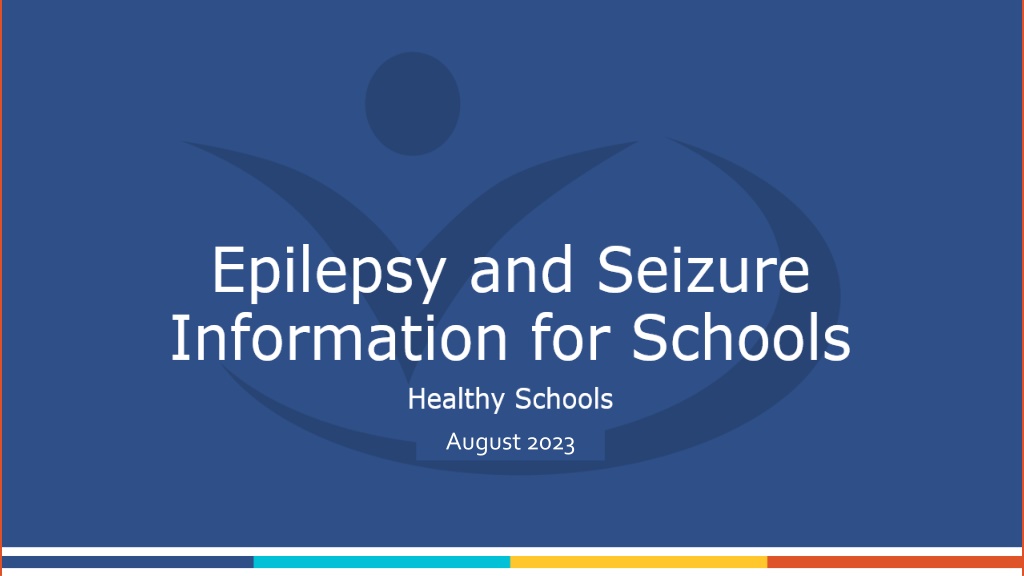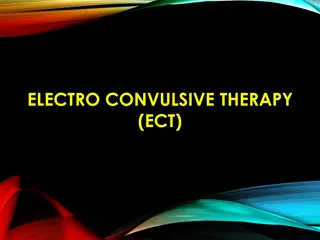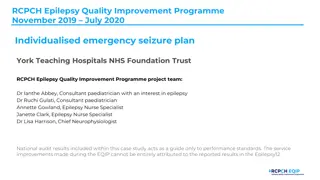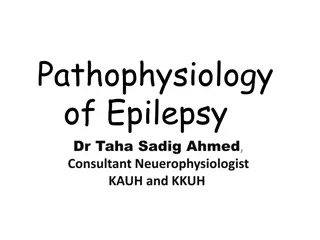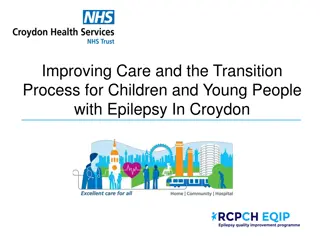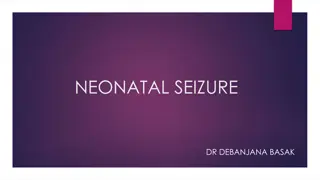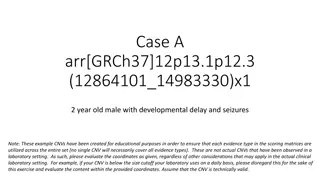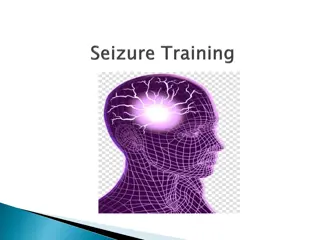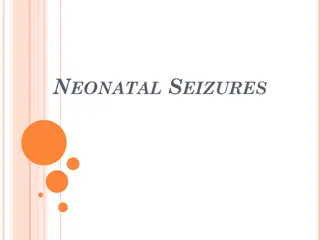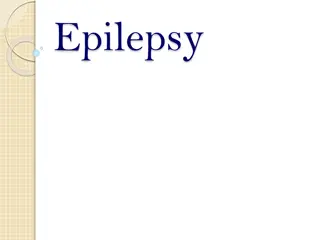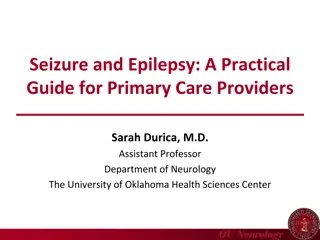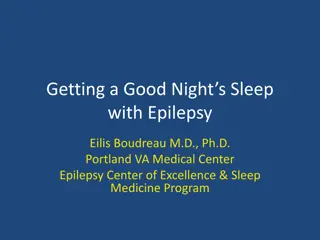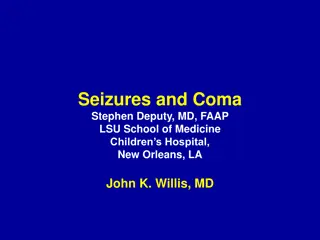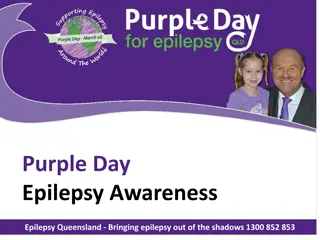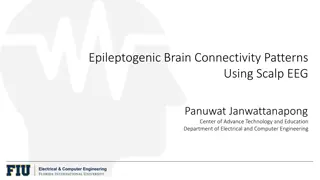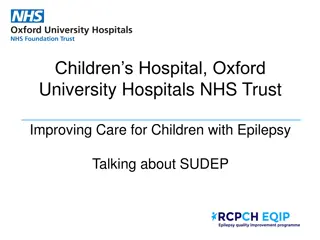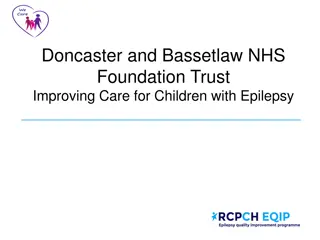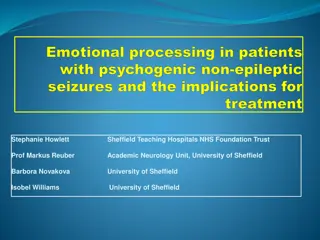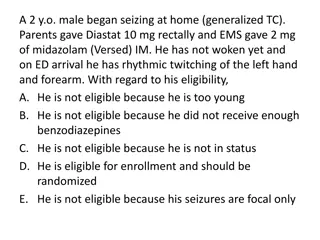Understanding Seizures and Epilepsy: A Comprehensive Guide
Explore the world of seizures and epilepsy to enhance your knowledge and learn how to provide optimal support for individuals with epilepsy. Discover the basics of seizures, signs to watch out for, the difference between seizures and epilepsy, and common causes of seizures. Empower yourself with essential information on this neurological disorder.
Download Presentation

Please find below an Image/Link to download the presentation.
The content on the website is provided AS IS for your information and personal use only. It may not be sold, licensed, or shared on other websites without obtaining consent from the author. Download presentation by click this link. If you encounter any issues during the download, it is possible that the publisher has removed the file from their server.
E N D
Presentation Transcript
Goal To help increase your knowledge of: Seizures Epilepsy how to best support the student with epilepsy basic first aid procedures for seizures
What is a Seizure? A seizure is a brief, temporary disturbance in the electrical activity of the brain and may affect: Muscle control and movement Speech Vision and/or eye movement Awareness and/or behaviour Seizures can be: Convulsive or non-convulsive Vary in frequency and severity Source: BC Epilepsy Society
Signs of a Seizure Uncontrollable jerking body movements Extended blank stare "Empty" look in eyes Mouth movements with a dazed look Rapid blinking Frothing at mouth Eyes rolling upward Loss of consciousness Periods of unresponsiveness Loss of body control Inability to pay attention Dazed walking Repetitive (tic-like) movements of body parts, usually head, arms, legs Temporary confusion Source: BC Epilepsy Society
Seizures vs. Epilepsy What is the difference? Epilepsy A chronic (ongoing) series of seizures, and can develop at any age. Seizures reoccur frequently and often without a known cause. Seizures Often symptoms of another health problem: diseases fever temporary medical, neurological or neurosurgical illness After the person is treated (illness is resolved) the seizures do not occur again
Epilepsy Neurological disorder that makes people susceptible to seizures Sometimes called a seizure disorder Can develop at any age Seizures are chronic (ongoing and frequent) Seizure can often happen without known cause Many people with epilepsy experience more than one type of seizure.
Why Do Seizures Occur? HEAD INJURY MVAs, Sports accidents Falls Head trauma BIRTH INJURY Brain injury to fetus during pregnancy & birth Perinatal asphyxia Postnatal vascular accidents INTRACEREBRAL INJURIES Tumours Strokes CONGENITAL DISORDERS INFECTION Meningitis Viral encephalitis Measles, Mumps Diphtheria METABOLIC DISORDERS HEREDITY Inherit different degrees of susceptibility to seizures FEVER
What can trigger a seizure? Stress Excessive excitement/stimulation Excessive fluid intake Extremely low blood sugar in diabetics Sunlight, heat, humidity Flickering lights Skipping meals and poor nutrition Illness, fever, allergies Lack of sleep Withdrawal from medicine, illegal drugs, or alcohol Missed medication Source: BC Epilepsy Society
Types of Seizures Focal (partial) GENERALIZED Occurs in PART of the brain Occurs in the WHOLE brain Tonic Atonic Tonic-clonic Myoclonic Absence Simple Partial Complex Partial https://www.youtube.com/watch?v=MZBGNVlaa2s
Treatment Medication Most common Seizures can be completely controlled in about 70% of all cases A control, not a cure *Goal: To use the least amount of drugs and to have the least amount of side effects Surgery may be effective for some children Special diet may be used in some cases
How does epilepsy affect a childat school? When managed effectively, and with support and planning, students with epilepsy should be encouraged to participate in all school activities. Some students may need extra support at school due to difficulties with learning, behaviour and/or mobility. Some children may occasionally be more sleepy than usual due to a recent medication adjustment. This should be temporary.
Classroom Considerations Because epilepsy affects the brain, it can affect the learning process. Accommodate varied attention spans and processing speeds by making provisions for: -access to alternative, quiet work areas -use of clear, explicit and visual instructions -regular breaks as needed -scheduling important and demanding activities after breaks -presenting 1 activity or idea at a time -provision of notes in advance or use of technology to record lessons -time extensions for tests and assignments -additional means for filing in potential gaps of missed content -consider participating in Purple Day in March and raising school awareness Source: Supporting Students With Epilepsy Section 3 (epilepsyontario.org)
First Aid 1. Stay calm 2. Time the seizure Note the time that the seizure starts and ends Most seizures last less than 5 minutes 3. Protect from harm: Move hazardous objects out of the way Do not put anything in students mouth
First Aid 4. Put the child into the recovery position Place something soft under their head Roll child on their side once seizure is ended and it is safe to do so. Loosen tight clothing, remove objects (i.e. glasses). 5. Document on the Seizure Record Form: Describe the seizure . How long the seizure lasted . How the person acted immediately before and after the seizure.
Recovery Reassure and provide comfort Talk gently to comfort and reassure the student Stay with them until they are re-oriented. Post seizure period: Check for injuries Call parents if necessary/as per care plan Allow student to change clothing if necessary Allow student to rest or sleep Student may complain of headache or be confused No food or drink until the student is fully awake and alert Have someone remain with student until fully recovered
When to call 911 Seizures do not always require urgent care. Call 911 immediatelyif: The person stops breathing for longer than 30 seconds. After calling 911 begin rescue breathing/CPR. The seizure lasts longer than 5 minutes. (The person may have entered a life-threatening state of prolonged seizure called status epilepticus). More than one seizure occurs within 24 hours, the person has diabetes or is pregnant. This is the student's first seizure; or if you don't know if the person has epilepsy. Serious injuries have occurred
You notice your student seems unwell. She cries out suddenly, falls down, and her body becomes stiff and starts to shake. What type of seizure do you think this might be? Tonic-clonic Absence Focal Case Study In this scenario you are already aware that this student lives with epilepsy and may experience a seizure while at school Adapted from For Educators Epilepsy Ontario
Case Study This student is likely to be experiencing a tonic- clonic seizure. What is your next action? Option 1: Call 911. Option 2: Stay calm, clear a space around the student and protect them from harm. Option 3: Restrain the student and put something in her mouth to keep her from biting down. Adapted from For Educators Epilepsy Ontario
Family Responsibility Provide specific information about their child Consult with their Doctor and provide the school with an annual Medical Alert Planning Protocol Supply labelled medications Make treatment decisions Ensure student wears a Medic Alert identification at all times Communicate with the school especially when there is a significant medical change with the student
School Responsibility 1. Ensure that school staff are aware of : which students have seizures seizure management protocol and seizure first aid School District policy regarding medical conditions at school 2. Medical Alert Planning and Request for Medication forms have been received from the family 3. Safely store the student s labelled medications 4. Document seizures in a seizure record 5. Communicate with the family
Questions ? For more information visit the Medical Conditions at School page on the Interior Health website
